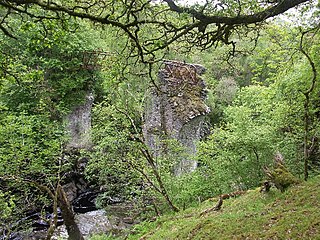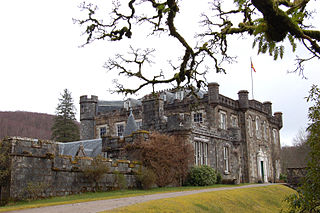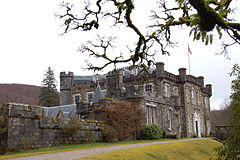
Loch Lochy is a large freshwater loch in Lochaber, Highland, Scotland. With a mean depth of 70 m (230 ft), it is the third-deepest loch of Scotland.

Sir Ewen Cameron of Lochiel was a Scottish soldier and the 17th Chief of Clan Cameron. He fought as a Cavalier during the Civil War and was one the principal Jacobite leaders during the 1689 Rising. He is regarded as one of the most formidable Scottish clan chiefs of all time. Lord Macaulay praised him as the "Ulysses of the Highlands" and further wrote, "Sir Ewen Cameron of Lochiel was in personal qualities unrivalled among the Celtic Princes. He was a gracious master, a trusty ally, a terrible enemy." An incident demonstrating Lochiel's strength and ferocity in single combat, when he bit out the throat of an enemy, is used by Sir Walter Scott in Lady of the Lake.

Clan Mackintosh is a Scottish clan from Inverness in the Scottish Highlands. The chiefs of the clan are the Mackintoshes of Mackintosh. Another branch of the clan, the Mackintoshes of Torcastle, are the chiefs of Clan Chattan, a historic confederation of clans.

Loch Eil is a sea loch in Lochaber, Scotland that opens into Loch Linnhe near the town of Fort William.

Clan Cameron is a West Highland Scottish clan, with one main branch Lochiel, and numerous cadet branches. The Clan Cameron lands are in Lochaber and within their lands lies Ben Nevis which is the highest mountain in the British Isles. The Chief of the clan is customarily referred to as simply "Lochiel".

The Battle of Mulroy was a Scottish clan battle fought in August 1688 in the Lochaber district of Scotland. It was fought between the Clan Mackintosh who were supported by government troops under Kenneth Mackenzie of Suddie against the Clan MacDonald of Keppoch who were supported by the Clan Cameron over disputed lands in the Braes of Lochaber. The battlefield has been inventoried and protected by Historic Scotland under the Scottish Historical Environment Policy of 2009.

Clan MacDonald of Keppoch, also known as Clan MacDonellof Keppoch or Clan Ranald of Lochaber, is a Highland Scottish clan and a branch of Clan Donald. The progenitor of the clan is Alistair Carrach MacDonald, 4th great-grandson of the warrior Somerled. The clan chief is traditionally designated as the "Son of Ranald's son".
The Clan MacDonald of Lochalsh was a Scottish family and a branch of the larger Clan Donald.

The Highbridge Skirmish was the first engagement of the Jacobite Rising of 1745 between government troops and Jacobites loyal to Prince Charles Edward Stuart. It took place at Highbridge, Lochaber, on the River Spean on 16 August 1745, and marked the commencement of hostilities between the two sides.

Archibald Cameron of Lochiel was a Scottish physician and prominent leader in the Jacobite rising of 1745. He was the personal physician of Charles Edward Stuart, and younger brother of Donald Cameron of Lochiel, otherwise known as the Gentle Lochiel, who led Clan Cameron during the rising. In 1753 at Tyburn, he was executed for high treason, being the last Jacobite to be executed. In popular memory, he is sometimes referred to as Doctor Archie.

Colonel Sir Donald Walter Cameron of Lochiel, was a British Army officer of the Queen's Own Cameron Highlanders, who served in the Second Boer War and the First World War, and the 25th Lochiel of Clan Cameron.

The Battle of Achnashellach was a Scottish clan battle said to have taken place in the year 1505, in the Scottish Highlands at Achnashellach. It was fought by the Clan Cameron against the Clan Mackay and the Clan Munro.

The Battle of Invernahavon was a Scottish clan battle between the Clan Cameron and the confederation of Clan Chattan that consisted of the Clan Mackintosh, Clan Macpherson, and Clan Davidson amongst others. Some sources give the date as 1386, others as 1370.

The Battle of Bun Garbhain was a Scottish clan battle fought in 1570, in the Scottish Highlands, between the Clan Cameron and the Clan Mackintosh.

The Stand-off at the Ford of Arkaig occurred in September 1665 at Achnacarry, about 10 miles (16 km) northeast of Fort William, Scotland. The Chattan Confederation led by the Clan Mackintosh assembled an army to challenge Clan Cameron in a 360-year-old dispute over the lands around Loch Arkaig. After a week of stalemate, the long-running feud was ended by a deal in which the Camerons bought the land from the Mackintoshes.

Kilmonivaig is a small village, situated close to the southeast end of Loch Lochy in Spean Bridge, Inverness-shire, Scottish Highlands and is in the Scottish council area of Highland.

Tor Castle is a ruined castle, about 3 miles north east of Fort William, Highland, Scotland, west of the River Lochy and east of the Caledonian Canal, near Torlundy.

Colonel Sir Donald Hamish Cameron of Lochiel, was a British Army officer, chartered accountant, landowner and the 26th Lochiel of Clan Cameron in the Scottish Highlands. He served as commanding officer of the Lovat Scouts throughout the Second World War. He succeeded his father as Chief of the Camerons in 1951 and later served as Lord Lieutenant of Inverness.
Hugh Fraser, 3rd Lord Lovat was a Scottish peer and Chief of Clan Fraser of Lovat from 1524 until 1544.

The Commando Basic Training Centre was a British Army training establishment primarily for the training of British Commandos during the Second World War. It was located in the grounds of Achnacarry Castle in the Scottish Highland region of Lochaber.






















